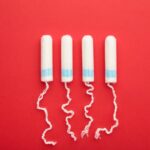PFAS in Menstrual Products
 Jamie McConnell Deputy Director |
What is PFAS and why should I be concerned?
Recent testing has detected PFAS (Per- and polyfluoroalkyl substances) in menstrual products like tampons, pads, and menstrual underwear. PFAS are considered “forever chemicals,” meaning they do not break down easily in the environment and are highly toxic. PFAS is a class of chemicals that includes 5,000 chemicals, so if PFAS is detected in a product, it’s one (or multiple) of those 5,000 chemicals. PFAS has been linked to a host of adverse health impacts, including cancer, infertility, birth defects, disruption of thyroid hormones, weakened immune system, high cholesterol, preeclampsia, and high blood pressure during pregnancy. And exposure at even low levels has been shown to harm human health (the dose DOES NOT make the poison). Yeah, it’s bad!
What has testing found?
In 2020, testing was released that found PFAS in Thinx menstrual underwear (Thinx recently settled a lawsuit regarding toxic chemicals in the company’s underwear). Newer testing of multiple brands of period underwear was released in 2021, and found 65% of the products tested had detectable levels of fluorine, indicating the presence of PFAS. And in 2022, testing was released finding PFAS in both tampons and pads. Testing for PFAS commonly employs methods include using “marker testing”—where the level of fluorine is detected in a sample. Because there are thousands of different types of PFAS, it is technically too difficult currently to test for every specific kind. However, as all PFAS contain fluorine, detecting fluorine is convincing evidence that PFAS is present.
Why is PFAS used in products?
PFAS are hydrophobic (meaning they repel water) and the chemical has commonly been added to fabrics to make them waterproof and to stop them from absorbing water. WVE has analyzed patent information from menstrual product manufacturers and found that several patents filed suggesting PFAS can be used for various functions in both menstrual pads and period underwear:
- As a hydrophobic coating on the surface of the pad (adjacent to the skin) so that any menstrual fluid is directed to absorbent layers underneath, and the top layer against the skin stays dry.
- As a waterproof coating on the bottom outer layer to make the product (pads and period underwear) leakproof – any fluid absorbed in the middle layers of the pad/underwear will be prevented from leaking through to outer clothing.
PFAS Contamination
It’s possible that in some cases PFAS is being detected in menstrual products not because it is being intentionally added by the manufacturer, but is a result of contamination or “unintentionally” added. In these cases the manufacturer should still be held responsible for contamination that may occur in the supply chain (i.e. where manufacturers are buying their materials from). It’s worth noting that when WVE evaluated the intentionally-added ingredients manufacturers are now disclosing as a result of an ingredient disclosure law in NY, not one manufacturer is disclosing PFAS. Still, PFAS contamination is concerning, as even low levels of PFAS contamination could pose a health risk.
Policy solutions
To address the issue, several states have introduced legislation banning PFAS in menstrual products:
- CA, AB 246, addresses the presence of PFAS in menstrual products.
- VT, S25, eliminates the use of certain toxic chemicals in menstrual products, including PFAS.
- NY, S.3529, eliminates the use of toxic chemicals in menstrual products, including PFAS.
- GA, HB 257, eliminates the use of toxic chemicals in menstrual products, including PFAS.
- RI, S196, bans PFAS in menstrual products.
Most of the current bills simply ban intentionally-added PFAS from products. In California, advocates are recommending amending AB 246 to address unintentionally-added PFAS, by including a maximum threshold above which PFAS is not allowed.
Specifically, advocates are recommending the following definition for PFAS:
“PFAS that a manufacturer has intentionally added to a product and that have a functional or technical effect in the product, including the PFAS components of intentionally added chemicals and PFAS that are intentional breakdown products of an added chemical that also have a functional or technical effect in the product”, as well as any PFAS, including contamination or unintentional use, above a specified threshold depending on the product category.”
There is precedence for this definition in California law, as it is included in the current ban on PFAS from clothing and apparel.
It’s important that legislation addressing PFAS in menstrual products also captures unintentionally added PFAS, as it is likely that its presence in some menstrual products could be due to contamination. The language advocates are recommending in CA is a good model other states can use.
It’s wonderful to see more states address issues of ingredient safety—the issue is clearly gaining traction and will help hold manufacturers accountable for what chemicals are used in products.
Want to stay updated on this issue? Sign up to receive emails to stay informed!





